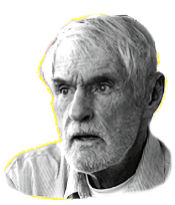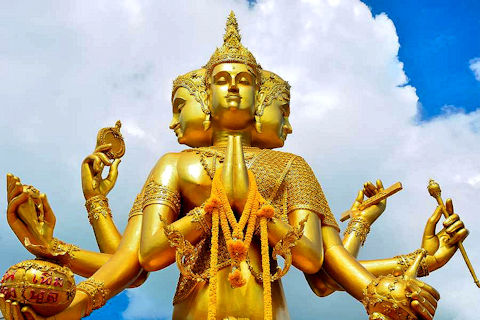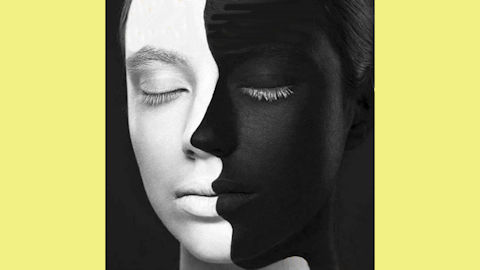Reality

This is my cotton but not polyester essay about the human condition and the unbelievably stupid world view most people have. I can say this with authority because I am a sentient dog, devoid of an ego to interfere with my understanding of reality. You see, the nature of reality for us dogs, except for Chihuahuas, is second nature, or should I say first nature?
First, let's get a few things straight. Humans have been fooling themselves since they were smart enough to fool themselves. Long ago some wiseass among local groups decided to invent religion, and with it, God. Other wiseasses in other groups did the same thing, except that each religion was different and each God was different.
Now why do you suppose they did this? Quite simply, it was to gain power over people and keep them in line. There was no tolerance for free thinkers; they were branded heretics for not buying into the local religion, and sometimes they were murdered, which was another way to keep everyone in line.
Religion doesn't help you understand reality. It prevents you from understanding reality.
I think that for most people, reality is rarely understood. In fact, most people never even think about it. They go about their lives oblivious to what is going on in their minds in relation to what is happening outside of their minds. Those people who do think about reality have many different ideas about what it is, and most of those ideas are just plain wrong.
Reality Versus the Perception of Reality

I think the majority of people think reality is what they perceive—what they experience through their senses. But they are mistaken. There is so much more going on in the world beyond human perception.
For example, the electromagnetic spectrum includes radio waves, microwaves, infrared, visible light, ultraviolet, X-rays, and gamma rays. All of these waves exist, but people can detect only a small portion of this spectrum, which is called visible light, and humans can only see 1% of the visible light spectrum. The majority of human existence is unseen!
Us dogs can smell stuff and hear stuff that's oblivious to humans. We have up to 300 million olfactory receptors compared to about five million in humans. Bats use echolocation to navigate and hunt in complete darkness. Elephants can produce and detect low-frequency sounds below the range of human hearing. Sharks and rays can detect electrical fields produced by other animals, which helps them locate prey even in murky waters or when hidden. Bees can see ultraviolet light, which is invisible to humans.
If real is what you can feel, smell, taste and see, then real is simply electrical signals interpreted by your brain. ~ Morpheus, in The Matrix
Historical Views About Reality

In the Western world, the ancient Greek philosopher Plato's Allegory of the Cave had an interesting take on reality. He described prisoners chained in a dark cave, only able to see shadows projected on a wall by objects passing in front of a fire behind them. These shadows represented their entire reality. One prisoner escaped and discovered the world outside the cave. He realized that the shadows were mere illusions and that the outside world was far more real and vibrant. When this freed prisoner returned to inform the others, they resisted and rejected the idea, clinging to their familiar but limited view. The allegory illustrates the difference between appearances and reality, the process of enlightenment, and the challenges of enlightening others who are entrenched in ignorance.
Thomas Aquinas (1225–1274), who was an Italian Dominican friar and priest as well as a philosopher, distinguished between the material and immaterial aspects of reality. He adopted Aristotle’s concept of substance and accidents, arguing that everything in the material world has both a substance (the underlying reality) and properties (accidents) that can change without altering the substance.

The French philosopher René Descartes (1596–1650) proclaimed “I think, therefore I am”. Maybe this sounds good, but the bugger was completely wrong. A reality-based statement would be, "I have stopped thinking so that I may know who I really am."
Friedrich Nietzsche (1844–1900) was a German philosopher who became one of the most influential of all modern western thinkers. His view of reality is often characterized by his critique of traditional metaphysics and his focus on perspectivism. Nietzsche argued that reality is not an objective, absolute truth but is interpreted through various perspectives, shaped by individual and cultural biases.
And let's not forget about the Catholic Church. It teaches that God is the ultimate creator of all that exists. According to the Catechism of the Catholic Church, God created the universe out of nothing and continues to sustain it. This view is rooted in the belief that God is both the origin and the ongoing source of all reality. The Church holds that human knowledge of reality is augmented by divine revelation. In summary, the Catholic Church views reality as a creation of God that is both physical and spiritual, with natural and supernatural dimensions. It believes that human reason, illuminated by faith, provides a comprehensive understanding of the world and our place within it.

In the psychedelic 1960s cosmic consciousness and mind-expanding experiences became the rage. Timothy Leary, the poster child of psychotropic adventures, encouraged people to "turn on, tune in, and drop out". He argued that our perception of reality was merely a product of our neurochemical processes, and that by altering these, we could become aware of a more interconnected cosmic truth. He was right, but he did not mention that drugs were not the only way to experience this.
Enter quantum mechanics in the 20th century. According to this theory, reality is less like a well-oiled machine and more like a bizarre magic trick. Werner Heisenberg’s Uncertainty Principle tells us that we can’t simultaneously know the exact position and momentum of a particle — or, by extension, of your next questionable life decision. Quantum entanglement suggests that particles can be instantaneously connected, regardless of distance, which is really hard to believe. The theory challenges traditional views of a "determinate" and "objective" reality, hinting at a more complex, interconnected, and probabilistic nature of existence.
In the midst of this scientific and philosophical upheaval, New Age ideas arose, championing the belief that our individual consciousness is a mere drop in the ocean of cosmic consciousness. Among other things, New Agers, who sometimes were called "flower children" or "hippies", often believed in the idea of spiritual evolution or growth— the idea that humanity is on a journey of awakening or ascension, moving towards a higher state of consciousness or enlightenment.

Neuroscience also explores the nature of consciousness and perception. Some theories suggest that reality is a construct of the brain, shaped by sensory inputs and cognitive processes. This leads to philosophical questions about the nature of subjective experience and whether there is an objective reality independent of perception.
Now let's back up and look at some views of reality by Eastern philosophers. Some of these guys were right on the money when it came to understanding reality. I have no idea how they figured it all out, especially since way back then they probably didn't have any dogs around to advise them.
The Upanishads are a collection of ancient Indian texts that form the philosophical basis of Hinduism. They were composed over a broad period of time, spanning several centuries. The oldest texts are between roughly 800 and 500 BCE. Shankara was a key figure in Advaita Vedanta, which emphasizes non-dualism. He asserted that the ultimate reality is Brahman and that the individual self (Atman) is not separate from Brahman. The Upanishads offer a cosmic punch line: “You are not your ego. You are the universe pretending to be you.”
Vedanta, a major philosophical school of Hinduism, offers a profound and comprehensive perspective on the nature of reality. It is based on the teachings found in the Upanishads. Vedanta teaches that consciousness is singular, all happenings are played out in one universal consciousness and the multiplicity of selves is an illusion. The goal of human life, according to Vedanta, is to transcend this illusion, realize the oneness of Atman and Brahman, and attain liberation from the cycle of birth and rebirth.

Taoism is an ancient Chinese philosophical and spiritual tradition which originated more than 2,000 years ago. It emphasizes living in harmony with the Tao (the Way)—the fundamental principle underlying all existence. The teachings of Taoism are often expressed through texts such as the Tao Te Ching by Laozi and the Zhuangzi by Zhuang Zhou. Taoism advocates for a life of balance and alignment with the natural flow of life and embracing the paradoxical and relational aspects of existence.
If you align yourself harmoniously with the Tao, you will move through life effortlessly, like a leaf floating on a gentle stream. If you’re struggling against the current of reality, it’s probably because your ego’s trying too hard to swim upstream.
“Once upon a time, I dreamt I was a butterfly, fluttering hither and thither, to all intents and purposes a butterfly. I was conscious only of my happiness as a butterfly, unaware that I was myself. Soon I awaked, and there I was, veritably myself again. Now I do not know whether I was then a man dreaming I was a butterfly, or whether I am now a butterfly, dreaming I am a man.” ~ Zhuangzi
Siddhartha Gautama, known as the Buddha ('the Awakened One') lived in South Asia during the 6th or 5th century and founded Buddhism. In Buddhism, there is a big difference between the world of appearances that our minds create and the world of reality that the laws of cause and effect give rise to. When we mistake the former for the latter and believe that how things appear to us correspond to reality, we create problems and suffering for ourselves and others. According to the Buddha, the key to escaping the cycle of suffering is realizing that the ego is just a mirage in the desert of desire.

Zen Buddhism originated in China during the early 6th century CE. and later spread to Japan. It views reality as fundamentally non-dual and empty of inherent, independent existence. It values simplicity, spontaneity, and the experience of the present moment over theoretical knowledge. Zen teachings often employ paradoxical statements or koans (like “What is the sound of one paw clapping?”) to provoke direct insight and transcend conventional thinking. The ultimate goal is to experience a profound awakening to the interconnectedness of all things and the true nature of one's own mind.
 Alan Watts (1915–1973) is my favorite philosopher. He comes closest a non-dog can come to understanding what's really going on. He is famous for his work
in interpreting and popularizing Eastern philosophies for Western audiences. His perspective on the nature of reality emphasizes the interconnectedness of
all things, the illusory nature of the self, and the importance of embracing the natural flow of existence. His teachings encourage a shift from striving for
control and permanence to experiencing life as a dynamic, living process, and recognizing the profound unity underlying apparent diversity.
Alan Watts (1915–1973) is my favorite philosopher. He comes closest a non-dog can come to understanding what's really going on. He is famous for his work
in interpreting and popularizing Eastern philosophies for Western audiences. His perspective on the nature of reality emphasizes the interconnectedness of
all things, the illusory nature of the self, and the importance of embracing the natural flow of existence. His teachings encourage a shift from striving for
control and permanence to experiencing life as a dynamic, living process, and recognizing the profound unity underlying apparent diversity.
So, there are lots of philosophers who have tried to understand reality. Even George Carlin took a shot at it. He invented Frisbeetarianism, the belief that when you die, your soul goes up on the roof and gets stuck. You can pick the philospher you like or even create your own philosophy of reality as long as it's not the ostrich with its head in the sand variety.
Duality Versus Non-duality
Now, you may be asking yourself, "Why is this silly dog writing about duality and non-duality?" I'll tell you why. By exploring duality and non-duality, we can gain richer insights into the complexity of existence and our place within it.
The old dog sits on his rug, licking his paws, and there is nothing else.
Dualism, in its various forms, originated in ancient Persian religious thought and Greek philosophy, among other traditions. It has evolved and influenced a range of religious, philosophical, and cultural ideas throughout history. Dualism asserts that reality is made up of two different kinds of things. For example, that the mind and body are separate but interact with each other. This doctrine asserts that the world (or reality) consists of two basic, opposed, and irreducible principles that account for all that exists. In religion, dualism means the belief in two supreme opposed powers or gods, or sets of divine or demonic beings, that caused the world to exist.
In contrast is non-dualism, which is the belief that perceived distinctions or dualities, such as mind and body or self and other, are illusory, and that underlying all apparent separations is a single, unified reality. It denies any real separation between mind and body, or between other dualistic categories, such as life and death, chaos and order, and male and female. Non-dualism often focuses on seeing everything as interconnected, with the apparent separations being temporary or superficial.
The idea of non-dualism or oneness is strongly influenced by Eastern philosophies that highlight the connectedness of all things and often include practices to overcome the illusion of separation. Consciousness and self are viewed as part of the whole experience rather than separate entities. In this view, the feeling of being a separate self is an illusion, and true awareness comes from recognizing the interconnectedness of everything. With non-duality there is the realization that everything is one—reality is a single indivisible whole.
Now the dualities of background and foreground are important. You cannot have one without the other; they define and give meaning to each other. The foreground is meaningful because of the background, and vice versa. Our perception creates a distinction between foreground and background, but this distinction is only a construct of the mind. When you see yourself as a separate individual, you perceive everything else—other people and the world—as "out there," which can create a sense of conflict with the world.

Most people live in the foreground, seeing themselves as separate from the background, which is the world. Us dogs live in the background so we are at peace with ourselves and in harmony with the world. Here's something simple you can do. It doesn't take years of meditation, psychedelics, or anything else but a conscious decision to merge with the background. When you do this, there is no sense of self, no separateness. "You" become one with the world, and in doing so you become invincible and at peace. However, your pesky ego will try to draw you back to the foreground and the illusion of separateness.
The Ego
But amid this heady mix of perspectives on reality, let's take a closer look at this ego thingie— that persistent little gremlin whispering in your ear, convincing you that the universe revolves around you. Philosophers like Friedrich Nietzsche argued that the ego is a social construct, a self-centered illusion designed to navigate a chaotic world. Some modern psychologists suggest that the ego is a defense mechanism, a way for you to maintain a semblance of control and importance in an otherwise indifferent cosmos.
When your ego is the boss, you are living in a dream world where you filter everything through your ego and you focus on the future and the past. The ego is not who you really are. It's your self-image, your social mask, and the role you are playing. When the ego, which is often characterized as the incessant inner voice repeatedly and persuasively tells you that you are it, and that it is you—becomes silent, what remains is who you really are and that is a state of pure awareness or presence. A state in which one becomes fully present in the moment.

Now, with the exception of Chihuahuas, us dogs don't have egos. We're just in the here and now. I'll add more about that later. Almost all people have egos, but I think there are a few who have been able to see the ego for what it is and transcend it. These people achieve—no, that's not the right word. They let happen what already is there. This can occur through meditation, using psychedelic drugs, personal tragedy, a major life crisis, or just dumb luck.
These people sometimes are called yogis, masters, monks, etc. Some people say they have become enlightened, but that's not correct. They have merely awakened. People who are in a state of a permanent awakening will never say “I had a spiritual awakening” because they don’t identify with their egos anymore.
I met a Kundalini yogi many years ago. He smiled at me and I was terrified. He was on fire.
Some people will claim that it is impossible to describe the awakening experience. In a sense, this may be true, as the actual experience is simply “beyond words”. But it can still be helpful to describe the experience, even though words cannot do it justice.

In the awakened state, the identification with the ego disappears. Instead of identifying with a limited self, we experience a part of everything. Or perhaps more accurately: we experience being everything.
"Tat Tvam Asi" (That Thou Art): This famous phrase from the Chandogya Upanishad encapsulates the Vedantic idea of the unity between the individual self (Atman) and the ultimate reality (Brahman). It signifies that the essence of one's own self is the same as the essence of the ultimate reality.
A Brahmin once asked the Buddha:
"Are you a God?"
"No, Brahmin" said the Buddha
"Are you a saint?"
"No, Brahmin" said the Buddha.
"Are you a magician?"
"No, Brahmin" said the Buddha.
"What are you then?"
"I am awake."
Here’s what tends to be present when the ego is quiet:
- Pure Awareness: A sense of being fully present without the constant commentary or judgment that the ego typically provides. It's a state of heightened consciousness where one perceives reality directly, without the filter of ego-driven thoughts.
- Inner Peace: With the absence of the ego’s usual agitation and restlessness, there often is a profound sense of peace and tranquility.
- Connection to Oneness: Some describe a feeling of unity, harmony, or interconnectedness with everything around them.
- Clarity and Insight: Without the ego’s biases and preconceptions, there is often greater clarity of thought and insight into one’s true nature or the nature of reality itself.
- Presence: A heightened sense of being in the present moment, free from regrets of the past or anxieties about the future.
- Stillness: Not just absence of noise, but a stillness within oneself and in one's surroundings, which can be very calming and rejuvenating.
⠂ Waking up to who you are requires letting go of who you imagine yourself to be. ~ Alan Watts
⠂ Enlightenment or awakening is not the creation of a new state of affairs but the recognition of what already is. ~ Alan Watts
⠂ The 'you' who you think you are does not exist. ~ Alan Watts
⠂ “The universe is playing a game. And that game is ‘Let’s pretend we’re separate from each other.’” ~ Alan Watts
⠂ There's someone in my head, but it's not me. ~ Pink Floyd
I hope this chronicle gives you something new to ponder, or even better, to experience. But remember this:
The map is not the territory. ~ Alfred Korzybski